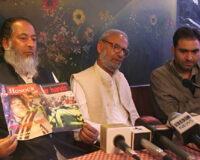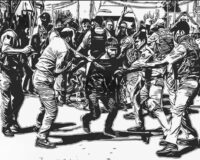Over the four years of India scrapping the special status of Indian occupied Jammu Kashmir, New Delhi’s most far reaching move to annex the UN recognized disputed territory and intensify the use of surveillance and predictive technologies to police and control civilian population of Kashmir. Subjecting Kashmiris to such scrutiny from security and military apparatus chokes all forms of expression and plunges them into a state of war.
Kashmiris are subjected to multiple layers of surveillance, aiming to monitor oppressed voices, restrict freedom of expression, and discourage their UN guaranteed Right of Self-determination. Surveillance in Kashmir resembles the panopticon– a design of institutional building with an inbuilt system of control proposed by utilitarianism philosopher Jeremy Bentham in the 18th century. The center panopticon is surrounded by watchmen to constantly monitor the behavior of prisoners. Foucault, in his analysis of the Panopticon, argues that its purpose is to arrange things so that surveillance attains permanence, even if it is discontinuous in its actions.
The Indian state has used manifold resources, both human and technology, to deploy a “strategic and comprehensive programme” as part of its counter-insurgency mechanism “leading to fear and its internalization”. The point is not only to watch Kashmiris through strategically placed cameras, but also—and what’s perhaps more insidious—to make them feel watched no matter where they are. Indian digital surveillance is thus the latest iteration of the counter-insurgency “demonstrating the control and fear.”
Kashmiris are subjected to Indian occupying authorities’ digital monitoring on a daily basis, at concrete bunker checkpoints, workplaces, universities, hospitals, and on social media. Since August 05, 2019 Kashmiris regularly experience breaches of their privacy by Indian occupying authorities in its attempt to monitor them and prevent opponents from expressing their opinions.
Daily life Surveillance
Kashmiris living under the prolonged military occupation have always suffered significant social control and monitoring, often in the form of unannounced Cordon and search operations (CASO) or brutal interrogation over the dissent on digital media. In the past 9 years, this monitoring has penetrated the digital realm and has been ramped up with digital technologies. Kashmiris are routinely monitored in public spaces, as occupying authorities deploy CCTV cameras in the streets of the Indian-occupied Jammu & Kashmir (IOJK).
The practice began in the year 2012 as Kashmir Digits reported in October 2021, that “Kashmir valley will witness increased security in terms of electronic surveillance as drone grids and CCTV will be installed in places that witnessed killings, in coordination with Indian Army and Central Security agencies.” Quoting news agency IANS, the report further stated “Jammu and Kashmir Police will be in a lead role in preventing attacks in coordination with other security stakeholders and they have been asked to strengthen the human intelligence gathering on the ground. Round-the-clock electronic surveillance in vulnerable areas, better intelligence networks, and strong patrolling on roads and highways around the cities to prevent entry and exit of the militants with more barricading and placing of security bunkers, will be the key features of the new security systems.
In April 2022, A Kashmiri based online news portal, Kashmir life reported that “the local state police headquarter has floated a tender for Union Territory-wide CCTV integrated network system with the primary focus on procuring high-resolution cameras having facility of face recognition, automatic number plates, color identified objects and stone pelting. A total 4,257 CCTV cameras were installed at 251 police stations and 88 police posts across occupied territory. Another order which came as a surprise for the private commercial entities from the occupying authorities, directing them to install good quality CCTVs and inform the police in case of any suspicious movement observed. The order further reads that any non-compliance would be punishable by a fine or a month’s imprisonment.
Akin to “blue wolf” tracking database of Israel in the West Bank, the Indian occupying authorities came up with innovative development to install digital door numbers to track the civilian population of IOJK.
Access and Data
The Indian occupying authorities maintain control over information and communication technology Infrastructure in the occupied territory thus depriving Kashmiris from their basic right, “right to access affordable and quality internet.” The internet has significantly amplified the amount of transitional data to be had for individuals everywhere. Monitoring is intended to improve the capture and tracking of the Kashmiris through the monitoring of social media, the monitoring of demonstrations and dissident speeches, and the monitoring of individual interest movements in political behavior.
Vasundasunhara Sirnate in her write-up published by The Hindu on November 2014, substantiated the heightened surveillance by stating “an intelligence bureau (IB) official stationed in occupied Kashmir told me that they were tapping 10,00000 phones in Kashmir alone by 2014. In August 2015, JK police said that “the department launch Electronic Surveillance Unit (ESU) in Anantnag southern district of IOJK to check cybercrime and take down the misuse of internet facilities especially by terror outfits. These ESUs were recently upgraded with modern technologies. In addition, the Indian occupying authorities use Israeli based snooping software company NSO to target human right defenders, journalists and resistance leadership.
A new development surfaced on September 25, 2023 where the region’s police department was granted unrestricted access to major social media platforms, including WhatsApp, X (formerly known as Twitter), Snapchat, Instagram, Telegram, and TiTok, for the purpose of monitoring citizens suspected of expressing dissent against the military occupation of their homeland. Given India’s status as an occupying power in Jammu and Kashmir, these measures are an extension of the occupation’s effort to assert complete control over the region and its populace
Social activists on various social media platforms have vehemently decried the oppressive actions of the Indian authorities, denouncing it as a flagrant infringement upon the sacrosanct realm of privacy rights. The Legal Forum for Kashmir,(LFK) international advocacy group, has taken decisive action by composing a letter addressed to the United Nations Special Rapporteurs imploring them to lend their formidable attention to India’s increasingly autocratic conduct in subjugating and exercising dominion over the denizens of the Indian Occupied Jammu and Kashmir (IOJK).
Surveillance of Minds
According to US-based rights group Stand with Kashmir (SWK) disclosed in the report that social media apps have continually silenced Kashmiri voices in the digital space. The body argues that corporations have removed content, suspended user accounts and engaged in algorithmic manipulation of content critical of India’s military occupation and settler colonialism in the region.
On August 14, 2020 an investigative report published by Kashmir Walla enunciates that Kashmiris are fearful of expressing opinions online and many have either deactivated their accounts or restricted their tweets to users who follow them on the platform. The word of mouth being spread among Kashmiri social media users warns of an ongoing crackdown by the police. Citizens keep their ideas to themselves and steer clear of initiatives to organize and mobilize resistance to oppression.
Conclusion
The civilian population of Kashmir including Human rights defenders, journalists and scholars have long drawn attention to their humiliation at the hands of innovative forms of surveillance that violate their privacy. In many ways, the case of the Kashmiri shows how technologies can be weaponized, particularly as a means of inducing self-censorship and compliance from people living in Indian occupied Jammu and Kashmir.
The advocacy groups in Kashmir need to organize globally to confront these technologies and collaborate with progressive civil society organizations in the struggle to end the abuse of these technologies by overzealous governments.
The encroachment of occupying authority and Armed forces on the spaces of Kashmir as well as other colonial subjects’ sow the seeds of terror in the hearts of the besieged population and prepares ground for the genocide of Kashmiris.






